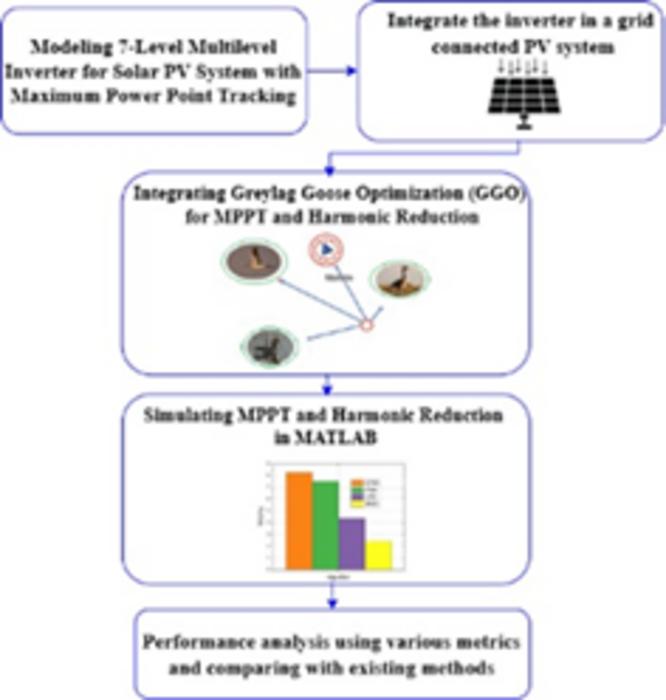A groundbreaking study has emerged, revealing a significant enhancement in the efficiency of solar photovoltaic (PV) systems specifically tailored for agricultural applications. This innovative research integrates an advanced algorithm known as the Greylag Goose Optimization (GGO) with a cutting-edge seven-level inverter, aiming to solve prevalent issues in PV technology, particularly in the context of fluctuating environmental conditions prevalent in agricultural settings. Researchers have made strides that allow for more efficient energy management, ultimately ensuring that farmers can rely on a stable and robust power supply.
The quest for reliable power sources in agriculture has never been more critical, with increasing demands for energy-efficient solutions amid rising operational costs. Traditional solar PV systems have typically struggled under highly variable conditions, limiting their effectiveness and leading to considerable energy losses. As conventional maximum power point tracking (MPPT) techniques fail to adapt to these conditions, the introduction of the GGO algorithm represents a revolutionary approach aimed at circumventing these pitfalls. The GGO algorithm simulates the migratory behaviors of greylag geese, resulting in a dynamic and efficient MPPT process that continually adjusts to maximize energy extraction from solar panels.
Researchers utilized MATLAB simulations to implement and analyze this new system’s performance, demonstrating its capability to optimize not only the energy output but also the quality of power supplied. The integration of the GGO algorithm with a seven-level inverter has yielded particularly impressive results, decreasing total harmonic distortion (THD) to levels as low as 1.95%. This stands in stark contrast to conventional methodologies, with alternatives such as salp swarm optimization and genetic algorithms yielding THD values significantly higher at 6.14% and 10.84%, respectively.
The ability of the seven-level inverter to produce a staircase waveform with a reduced number of switches minimizes THD, thereby delivering cleaner, high-quality alternating current (AC) power essential for sensitive agricultural machinery. The implications of this technology extend beyond just energy efficiency; it translates into reduced wear and tear on equipment, less frequent maintenance, and ultimately, lower operating costs for farmers.
In the agricultural landscape, where the proper functioning of irrigation systems, ventilation, and other critical machinery is paramount, achieving high-quality, efficient energy delivery is non-negotiable. The research carried out by a team from Annamalai University has paved the way for a paradigm shift in how agricultural energy systems can be conceptualized and deployed. With the ability to switch seamlessly between grid-connected and off-grid modes, this new PV system is particularly adaptable, catering to the diverse energy needs of modern agriculture.
Moreover, the study highlights how bio-inspired algorithms like GGO can modify existing systems to enhance their performance. The method of continuous adjustment to the PV array’s operating point ensures that maximal energy extraction is maintained irrespective of changing weather or environmental conditions. Such advancements not only promise economic benefits but also align with sustainability goals by reducing reliance on fossil fuels in farming operations.
As the agricultural sector increasingly embraces renewable energy solutions, the significance of reducing THD in power supply cannot be understated. High total harmonic distortion can lead to inefficiencies and potential damage to electrical equipment, increasing costs and downtime for farmers. Thus, the adoption of technologies that create a stable energy output with low harmonic distortion is essential for optimizing agricultural operations and fostering greater energy independence.
The potential of the GGO-integrated PV systems extends beyond agriculture; it signifies a leap forward for renewable energy technology in various sectors. The research team’s findings are expected to resonate with energy policy makers, environmentalists, and agricultural planners looking for solutions to contemporary energy challenges. As industries evolve and look towards sustainable options, innovations like this may serve as a blueprint for integrated renewable energy systems that can address diverse energy requirements efficiently.
The positive feedback from Dr. K. Rajaram, the lead researcher, underscores the transformational nature of this study. He expressed confidence that combining the GGO algorithm with avant-garde inverter technology creates a dependable energy solution capable of meeting rigorous agricultural demands. As renewable energy systems make strides towards effectiveness, advancements like this solidify the potential for green technology to play a pivotal role in the agricultural revolution.
In conclusion, the advancements made by this research team underscore the potential for bio-inspired optimization techniques to redefine energy management in agriculture. By utilizing sophisticated algorithms in conjunction with innovative inverter technology, researchers are setting the stage for a future where agricultural dependency on conventional energy sources diminishes, leading to a more sustainable food production landscape. The synergy of renewable energy and modern farming presents an exciting frontier for technological advancement and sustainability practices.
With the growing demand for efficient energy solutions, this innovative approach marked by the GGO algorithm could revolutionize agricultural practices, offering farmers an intelligent and effective means to optimize energy use and minimize costs while contributing towards environmental sustainability. The successful application of these advanced methodologies in real-world settings marks a significant milestone towards achieving energy efficiency in agriculture, promising a cleaner, greener, and more sustainable future for the sector.
Furthermore, the potential ramifications of this breakthrough extend beyond mere technology; they touch upon broader socio-economic issues, offering solutions to energy poverty in rural regions and enhancing food security by ensuring that agricultural systems can operate uninterrupted. As enthusiasm for renewable energy swells, the spotlight is firmly on this innovative research, urging broader adoption and consideration into regulatory frameworks for modern agricultural energy solutions.
Subject of Research: Greylag Goose Optimization for efficient MPPT and seven-level inverter in renewable energy systems
Article Title: Harnessing Greylag Goose Optimization for Efficient MPPT and Seven-Level Inverter in Renewable Energy Systems
News Publication Date: January 16, 2025
Web References: Energy Storage and Saving Journal
References: DOI: 10.1016/j.enss.2024.12.002
Image Credits: K. Rajaram, R. Kannan
Keywords: Renewable energy, solar PV systems, maximum power point tracking, Greylag Goose Optimization, harmonic distortion in agriculture, energy efficiency, agricultural technology




